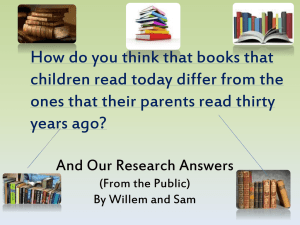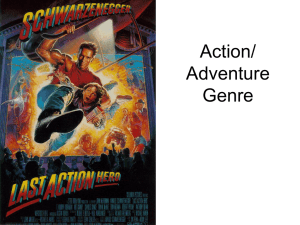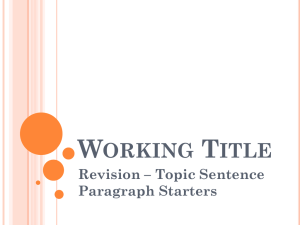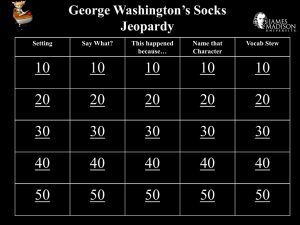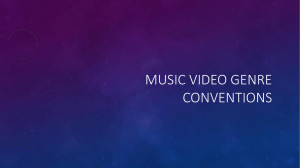the notes from lesson 1
advertisement
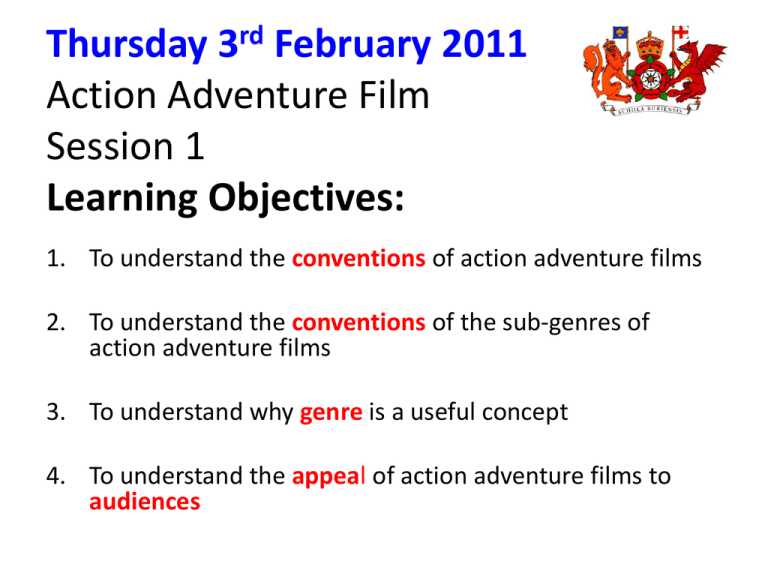
Thursday 3rd February 2011 Action Adventure Film Session 1 Learning Objectives: 1. To understand the conventions of action adventure films 2. To understand the conventions of the sub-genres of action adventure films 3. To understand why genre is a useful concept 4. To understand the appeal of action adventure films to audiences Homework Media: 1.Complete Todorov grid 2.Print PPT from website and stick in book 9th Feb The Exam Monday 13th June 2011 1 ½ hours 4 unseen tasks to be responded to in role Pre-release brief issued on Monday 16th May Brief provides a contextualised scenario (this is NOT the same as previous years where the actual questions were made available) Only 1 tier – no higher/ foundation split Card sort Sort the film titles that you have been given into groups – it is up to you how you group them Why have you grouped them in this way? Possible sub-genres Western Fantasy Quest Thriller/suspense Historical Martial Arts Swashbuckler Sub-Genre Conventions For each sub-genre, brainstorm conventions. Use film titles from card sort and others you know of to help you Consider: • plot/sub-plots • characters/relationships • location/s • stunts/special effects • music/sound • cinematography/editing • appeal to audience Genre Conventions What do these films have in common? So what are the conventions of Action Adventure? Conventions of Action Adventure Films include: theme of good vs evil fast pace Strong male hero (protagonist) Bombshell love interest Guns/explosions Fights: punch ups, martial arts, shoot outs Heroic acts, stunts Chases: car chases, helicopter chases, plane chases, foot chases, boat chases, etc. Evil character (the antagonist) determined to destroy the world/kill the hero/steal massive amounts of money Comedy moments The film is plot driven The hero reflects and upholds the current morals of society A vibrant title that evokes the action, adventure, and premise of the story is a key component to the genre. The villain has a masterful Plan: the villain’s plan provides the catalyst for the hero’s adventure. The villain’s plan sets up the hero’s goal (which is to stop the villain’s plan.) The villain is more powerful than the hero Snappy dialogue: especially in stories where the hero has a buddy or ally or mentor to spar with. Concept of genre What is genre? a way of categorising a text through style and form How do we decide which genre/s a text belongs to? through the identification of key elements which occur in that text and in others of the same genre these elements may be referred to as paradigms, and range from costume to music to plot points to font (depending on the medium). These paradigms may be grouped into those relating to - iconography (ie the main signs and symbols that you see/hear) - structure (the way a text is put together and the shape it takes) - theme (the issues and ideas it deals with) Why is genre an important concept? for audiences for producers Why is genre an important concept? Audiences: select texts on basis of genre, often because texts are arranged at retail outlets by genre (just pop along to HMV). Also, certain genres are considered appropriate to certain ages/genders in society, and choices are made accordingly e.g. teen movies, 'chick flicks’ have systems of expectations about the content and style of a text, according to its genre. This enables the audience to take particular pleasures in the text, those of repetition, and of predicted resolution. Pleasure may also be drawn from differences. identify with repeated elements in generic texts and may shape their own identity in response (eg fans of a particular genre of music dress in a specific way - metalheads in their band t-shirts, for instance) Why is genre an important concept? Producers market texts according to genre because a niche audience has already been identified as taking pleasure in that type of text standardise production practices according to genre conventions, thus cutting costs subscribe to established conventions of versimilitude, thus reinforcing genre conventions, but also allowing creativity within a given format e.g. it is an accepted convention in science fiction that spaceships make noises, which helps create excitement in battle scenes, but it is a scientific fact that no sound travels through the vacuum that is space. Write a narrative profile for conventional target audience of action adventure films name age occupation hobbies/interest other media texts consumed e.g. music/TV/internet how often and in what format they watch action adventure films What is the appeal of action adventure films for this audience? Remember Uses and Gratifications Theory? As we revise this, make a note of which could be reasons that the target audience watch Action Adventure films. Uses & Gratifications Theorists Blumler & Katz (1974) came up with 4 main uses we have for consuming the media: 1.Diversion 2.Personal relationships 3.Personal identity 4.Surveillance U & G- Diversion Escaping from problems Relaxing Filling time Emotional release U & G- Personal Relationships Social empathy Finding a basis for conversation Helping us to connect with family, friends and society U & G – Personal Identity Finding reinforcement for personal values Finding models of behaviour Gaining an insight into yourself U & G- Surveillance Finding out about events in society and the world Seeking advice on matters of opinion and decision choices Satisfying curiosity and general interest Education Do you agree? Read the following statements Place yourself on the value line, depending to what extent you agree or disagree with the statement Be ready to justify for position Narratives of Action Adventure films are boring as they are formulaic. Representations in Action Adventure films are sexist. Action Adventure films typify ‘mass-produced’ entertainment and have no lasting value or worth. Action Adventure films are too often simply part of an industry franchise; an attempt to promote video games and other merchandise. Action Adventure films are simply dumb films for dumb people.
